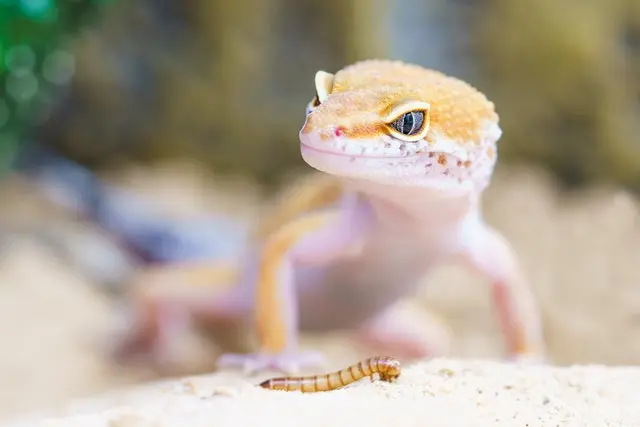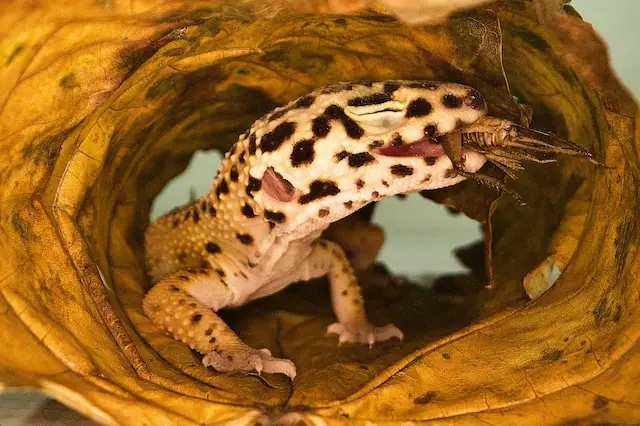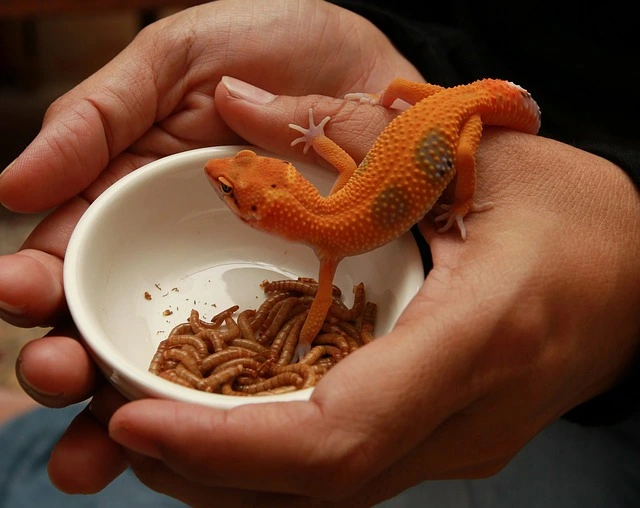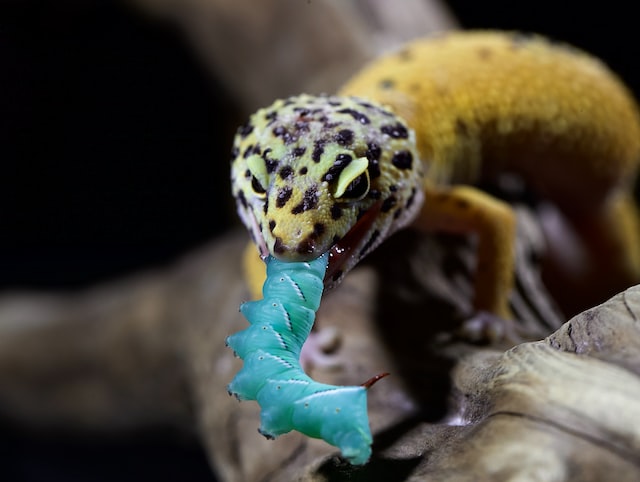Leopard geckos are carnivores and are known to eat a variety of foods such as:
Crickets, mealworms, wax worms and silkworm. As a pet owner, you way be wondering which one is the best option for your spotted little lizard.
In this article we will talk about the different diet options on a leopard gecko and give you recommendations on how to keep your pet happy and well fed.
What do leopard geckos eat?
Geckos have been known to eat everything from mealworms, crickets, grasshoppers and wax worms all the way up through silkworm pupae. Silkworms, however are rarely fed to leopard geckos due to their high cost and difficulty to find and raise. Grasshoppers have a slightly tougher chitinous shell, but are a good source of protein like crickets. Some people also treat their leopard gecko’s diet with king worms (a larger variety of meal) but these should only be considered an occasional delicacy because they contain more fat than protein which can lead your pet into obesity if it is fed regularly over time – this will probably not happen overnight though so give them a try before you write off any other possibility!
Do leopard geckos eat fruit?
No, you should not be feeding your leopard gecko any fruit. We have taken a deeper dive into the topic of fruit in out guide called “Can Leopard Geckos Eat Fruit?“
Crickets vs. mealworms, which one is better for my gecko?
Whichever you choose, you won’t go wrong. These are the two most common types of food for pet leopard geckos. However, here is a short comparison of the two options:
Crickets
| Pros ✔️ | Cons ❌ |
|---|---|
| More active, stimulate the gecko’s hunting instincts; | If you buy in bulk you have to feed them to keep them alive; |
| Contain slightly more fluid, protein, calcium and vitamin C than mealworms; | Crickets not eaten in the terrarium will irritate the gecko by climbing on it and biting it; |
| Their exoskeleton (integument) is softer than that of mealworms; | Hungry crickets may eat the gecko’s droppings, leading to the development of infections after eating the cricket; |
| Higher escape risk; | |
| Noisy at night; |
Mealworms
| Pros ✔️ | Cons ❌ |
|---|---|
| Lower escape risk, as they do not move very fast; | Not as stimulating, do do not trigger hunting instincts; |
| You can buy in bulk and freeze them; | Requare a separate bowl in the terrarium, which increases the number of things you have to clean; |
| They are silent; | The worm shell is a little harder, more difficult to digest; |
| If they escape the bowl, the worms will bury themselves in the sand and may rot and die in there, causing an unhzgienic environment; |
How to best feed mealworms to your leopard gecko
Worms can be put in plastic food bowls or whatever you have on hand.
It is very important to feed the worms before giving them to the gecko. This is done by giving the targeted worms food, a carrot and some calcium powder. These contain minerals and supplements needed by the animal.

Pro tip: Putting some of the powder in the worm bowl with the gecko will keep the worms powdered with it even after the gecko has eaten. The other plus is that the animal can ingest more of the calcium in the mix while catching the worms. Another thing you can do is put a piece of carrot in the gecko’s bowl. It will make the worms feed and wiggle, stimulating the gecko.
Tips on feeding crickets to your leopard gecko
While feeding your gecko live crickets may seem daunting at first, there are a few simple tips you can follow to make sure your gecko gets the nutrition they need. First, it’s important to choose the right size cricket for your gecko.

If the cricket is too large, your gecko may have difficulty digesting it. Conversely, if the cricket is too small, your gecko may not get enough nutrition.
Once you’ve selected an appropriately sized cricket, you’ll need to offer it to your gecko in a way that minimizes the risk of escape. Some common methods include using tongs or placing the cricket in a cup or bowl.
You should also provide your gecko with a hiding spot, as this will help them feel more secure while they eat, especially if itis still young and not used to its surroundings.
Pro tip: always feed the crickets some lettuce, carrots or any other greens before feeding them to your gecko. To make them even more nutritious, sprinkle some calcium powder on their food.
Our recommendation: best diet for a leopard gecko
To make sure your gecko receives the best possible care we recommend a mixed diet. Feed your gecko mainly crickets but treat it with mealworms once a month. Monitor its habits and reaction to the different foods. Some geckos simply prefer one over the other.
Ultimately, it depends on your gecko’s individual needs. If you’re not sure what to feed your gecko, talk to your veterinarian for guidance.
FAQ about feeding your Leo:
How often should you feed your leopard gecko
When it comes to how often you should feed your leopard gecko, there is no one-size-fits-all answer. Some factors that will influence how often you should feed your gecko include its age, size and whether you are feeding it live food or insects that have been frozen.
Young geckos should be fed every 1-2 days. This is because they have a high metabolism and need to eat more often to stay healthy. Adult geckos can be fed every 2-3 days, while senior geckos can be fed every 3-4 days
The size of the gecko will also influence how often you should feed it. A smaller gecko will need to eat more often than a larger gecko.
What should you feed your leopard gecko
Leopard geckos should be fed a diet of live, moving insects. Commercially bred crickets are a good source of nutrition for these lizards, but they should also consume lesser quantities of silkworms, roaches, mealworms, superworms, waxworms, and other live insects.
Can I feed my leopard gecko every day?
No. Only leopard geckos younger than one year should be fed every day. Feeding an adult leopard gecko daily will result in the lizard becoming obese. Adult leopard geckos should be fed every other day or every third day
What happens if I don’t feed my leopard gecko enough?
If a leopard gecko does not receive enough food, it may become malnourished and weak. A lack of food can also stunt the growth of a young lizard.
How much should I feed my leopard gecko a day?
When it comes to feeding your leopard gecko, it is important to strike a balance between providing enough food to support growth and avoiding obesity. Baby leopard geckos should be fed 5-6 small crickets or 3 mealworms every day until they reach about 4 inches in length. At this point, they can be transitioned to an adult diet of 2-3 large crickets or mealworms 2 to 3 times a week. By following these guidelines, you can help ensure that your pet leopard gecko stays healthy and lives a long and happy life.
What is the best time of day to feed a leopard gecko?
As any pet owner knows, feeding time is an important part of the day for both animals and humans. But when is the best time to feed a leopard gecko? Since these lizards are nocturnal, they are most active at dusk and dawn. These times of day offer a perfect balance of light and temperature for leopard geckos, making them the ideal hours to eat. So, if you’re wondering when to feed your leopard gecko, the answer is at dusk or dawn.
How do I know if my leopard gecko is hungry?
As any reptile keeper knows, leopard geckos are popular pets due to their docile nature and relatively easy care requirements. However, one of the challenges of keeping a leopard gecko is knowing when to feed them. If your leopard gecko is well-fed, he will be active and attentive, and will readily wander his tank in search of food. He will also be quick to move towards the glass if he sees you, as he will associate you with food. On the other hand, a hungry leopard gecko will be sluggish and unresponsive, and may even spend most of his time hiding. If you are unsure whether your leopard gecko is hungry, it is always best to err on the side of caution and offer him a meal. By doing so, you can help to ensure that your pet stays healthy and happy.
How often do leopard geckos drink water?
One of the things that makes leopard geckos such good pets is that they’re easy to care for. When it comes to hydration, for example, you only need to provide your leopard gecko with fresh water once a day. The water should be in a dish that’s big enough for the lizard to submerge its entire body. It’s also a good idea to give your leopard gecko occasional soaks in shallow, warm water. This is especially important during shedding, when the reptile’s skin is especially delicate. Soak your leopard gecko for 15-20 minutes, 2-3 times each week. With just a little bit of care, your leopard gecko will stay healthy and happy for many years to come!
Can I feed my leopard gecko just mealworms?
Many people choose to feed their leopard geckos mealworms because they don’t have to deal with the odor, loudness, or other drawbacks of crickets. Just keep in mind that mealworms provide more fat than crickets and too many mealworms can make your gecko overweight. If you decide to feed your leopard gecko a diet of only mealworms, be sure to monitor their weight and overall health closely. With a little care and attention, your leopard gecko can thrive on a diet of mealworms.

Is it okay to leave crickets in with my leopard gecko?
Many leopard gecko owners choose to leave crickets in their terrariums overnight, but this can actually be damaging to your leopard gecko’s health. The leopard gecko may get stressed or injured if live crickets attack it within the tank. They could even die and rot in the tank of your gecko, concealed elsewhere.
What to do if your leopard gecko refuses to eat
If your leopard gecko refuses to eat, you may need to try different types of food. You can also try mixing different types of food together to see if your leopard gecko will eat any of them. If your leopard gecko still refuses to eat, you may need to take it to a veterinarian for a check-up.
Can you handle a leopard gecko after eating?
As any leopard gecko owner knows, these lizards are delicate creatures that need to be handled with care. One important rule of thumb is to avoid handling your leopard gecko after it has eaten. This is because the lizard needs to lay flat in order to properly digest its food. If you try to pick it up or move it around after it has eaten, it can end up regurgitating its meal. Not only is this unpleasant for the lizard, but it can also lead to improper digestion and other health problems. So if you want to avoid a messy situation (and a unhappy lizard), it’s best to handle your leopard gecko before giving it food. That way, it will associate you with a positive experience and be more likely to cooperate when it’s time for a meal.
